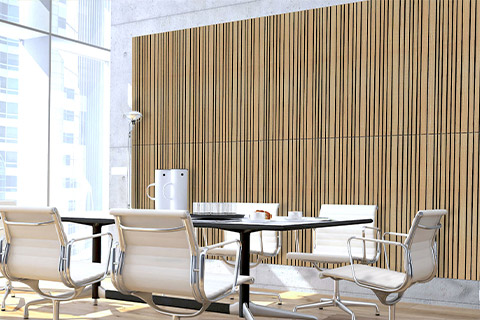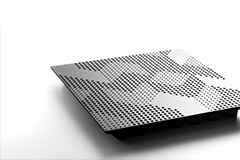We all know it from large, hard rooms with poor acoustics, especially if many people are talking at the same time or music is playing. Poor acoustics and too long reverberation time are experienced in that it can become directly
unpleasant to talk together or listen to music, as the sound reflections from hard/smooth walls and floors destroy the direct sound and speech by being too powerful /audible (too long reverberation time).
Poor acoustics can be greatly improved by using acoustic-absorbing materials, depending on the extent of the room and the acoustic problem.
The trick is to find the right balance so that the room's reverberation time is homogeneous over the entire frequency range, and of course depending on how strong the attenuation must be for the purpose, e.g. everything from acoustics in a church, the home, venues or cinemas.
There is a wide range of different sound absorbers, ranging from relatively cheap Troldtekt ceilings to insanely expensive designer absorbers. At AV-Connection we have, among other things, selected a range with a focus on high, precise efficiency, nice design and high quality at reasonable prices from
Artnovion.
Besides the reverberation time, another challenge is often standing waves (e.g. bass zones). Therefore, the good acoustics are often achieved by using a combination of both absorbers, diffusers and bass traps, if you really have to go for it.

Unwanted noise in work environments can lead to impaired concentration and productivity, and acoustic panels can help minimize these problems. When choosing acoustic panels for businesses and institutions, it is important to consider both aesthetics and functionality. The panels must match the interior design of the room and at the same time meet the necessary acoustic requirements. Acoustic panels are available in different materials and thicknesses, and it is important to choose panels that suit the room size and sound needs.
Typically, sound-absorbing panels are used in commercial and institutional environments, as they help dampen unwanted reverberation and reduce standing waves. In addition, diffusers can also be used to spread the sound more evenly in the room and avoid sharp reflections.
The panels can be placed on the wall and ceiling in commercial and institutional premises to achieve the best effect on the acoustics. It is important to place the panels correctly so that they cover the areas where the sound is reflected the most. It is often recommended to place the panels on the front and back walls, as well as on the ceiling above the workplaces.
In business and institutional environments, it may also be relevant to choose panels that are fire-resistant and difficult to damage. In addition, there may also be a need for panels that are easy to clean and maintain.
In addition to improving the working environment, acoustic panels can also contribute to a more pleasant atmosphere and give the room a more professional look. They can be an important part of the interior design and give the room a personal touch.

In a studio, it is important to minimize unwanted reflections and standing waves, which can affect the sound quality and create sound distortions. Acoustic panels can absorb these unwanted sounds and provide a clearer and more detailed sound experience.
When choosing acoustic panels for a studio, it is important to consider both aesthetics and functionality. The panels must match the interior design of the room and at the same time meet the necessary acoustic requirements. Acoustic panels are available in different materials and thicknesses, and it is important to choose panels that suit the room size and sound needs.
Typically, sound-absorbing panels are used in studios as they help dampen unwanted reverberation and reduce standing waves. . In addition, diffusers can also be used to spread the sound more evenly in the room and avoid sharp reflections. The panels can be placed on the wall and ceiling of the studio to achieve the best effect on the acoustics. It is important to place the panels correctly so that they cover the areas where the sound is reflected the most. It is often recommended to place the panels on the front and back walls, as well as on the ceiling above the listening position.
In a studio, it may also be relevant to choose panels that are fire retardant, as there may be many electrical appliances and equipment present. In addition, there may also be a need for panels that are easy to clean and maintain.
In addition to improving sound quality, acoustic panels can also contribute to a more comfortable and productive working atmosphere in the studio. They can be an important part of the decor and give the room a more professional look.




